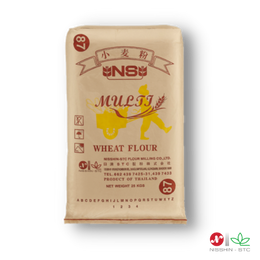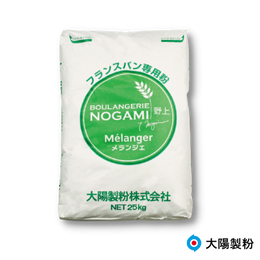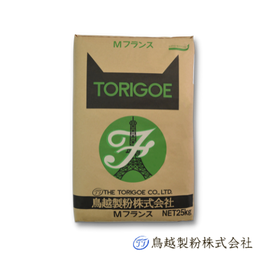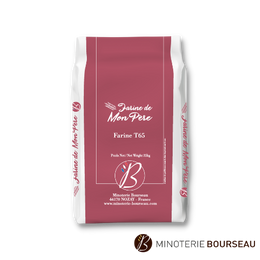Baguettes are a type of French bread that is known for its long, thin shape and crispy crust. They are typically made with wheat flour, water, yeast, and salt. However, the type of flour used can have a significant impact on the aroma, taste, and texture of the baguette.
In this post, we compare four different types of wheat flour for making baguettes:
Each of these flour are medium protein flour, with their own respective characteristics. In this experiment, we want to explore how the different flour characteristics affect the final end product including the bread's flavor, aroma, colour, volume and texture.
STRAIGHT DOUGH METHOD WITH AUTOLYSE
For this experiment, we used the straight dough method combined with autolyse and overnight fermentation. For each flour type, we adjusted only the water ratio to get the same dough texture.
We used the autolyse method as that can improve the quality of your bread. To use the autolyse method, we simply mix the flour and water together until they are just combined. Then, we let the dough rest for 30 minutes. During this time, the flour will fully absorb the water and the gluten will begin to develop.
After 30 minutes, we add the yeast, mix well to combine, followed by the salt and knead the dough until it is smooth and elastic. When the dough develops approximately 70% of its gluten, we add the remaining water. This method helps achieve dough that's more chewy with even air pockets, which in turn affects the overall bread's texture.
THE EFFECT OF FLOUR TYPE ON BAKING RESULTS: IS THERE REALLY A DIFFERENCE?
We previously shared in this article about how the amount of protein and ASH in high protein flour affects the final product. The same theory applies to this experiment as well.
Theoretically, the amount of protein affects the texture and volume of the bread, whereas the ASH content affects the bread colour, aroma, flavour and texture as well.
Most bread are made with only a few ingredients, with flour and water being the most fundamental. Even this baguette recipe calls only for 4 staple ingredients:
- flour
- water
- dried yeast
- salt
In this experiment however we also found that the wheat origin and type, as well as the method in which the flour was milled, along with the hydration level also impacts the final product. Hence why the type of flour used is important, as it dictates the outcome of the bread.
Given the minimal ingredients required, we can imagine how each ingredient has a big impact on the final product. For example, one of the ingredients that has a big impact is water.
This is because different types of flour have different hydration levels. This is because the protein content of the flour affects its ability to absorb water. Generally, flours with a higher protein content can absorb more water. This is however just a general guideline, as the actual hydration level of a flour may vary depending on the brand and the milling process.
In this experiment, we adjusted the hydration percentage of each flour until the dough textures were as similar as possible.

BUT DOES HYDRATION MATTER?
Simple answer, yes. The hydration level plays an important part because it impacts everything about your bread’s structure. From volume, to interior crumbs, down to texture and chew, and even external crust.
What is hydration? In breadmaking, the hydration percentage is the ratio of water to flour in a dough, expressed as a percentage. For example, a dough with 75% hydration means that there are 75 grams of water for every 100 grams of flour.
Here's how the hydration percentage affects the bread dough in a number of ways:
- Volume: A higher hydration level will produce a bread with a larger volume. This is because the water molecules will help to create air pockets in the dough during baking.
- Crumb structure: A higher hydration level will produce a bread with a more open crumb texture. This is because the water molecules will help to create air pockets in the dough during baking and ensure that the air pockets are more evenly distributed.
- Crust: The higher the hydration percentage, the thinner and crispier the crust will be. This is because the water molecules will evaporate during baking, leaving behind a thin, crispy crust.
- Air bubbles: A higher hydration level will produce a bread with more air bubbles. This is because the water molecules will help to create and stabilize the air bubbles in the dough.
In general, a higher hydration percentage will produce a bread with a more open crumb structure, a thinner and crispier crust, and higher volume. Of course, other factors such as protein and ASH% also play its role.
FOUR TYPES OF FLOUR, ALL DIFFERENT RESULTS
This experiment illustrates the contrast between the baguettes using flour of varying origin, protein and ASH content:

It is apparent from the image above that the colour, crumb structure, and even volume differs for each baguette.
Let's take a closer look at each of the loaf to explore the difference externally:

- COLOUR: Melanger & T65 has higher ASH% hence the darker colour
- VOLUME: Multi & France both has higher protein % and higher hydration, hence the bigger volume

Now looking at the interior crumbs, we can also note that:
- CRUST: Multi & France has lower ASH % hence the thinner crust as opposed to Melanger & T65 that has a thicker and harder crust due to higher ASH%
- CRUMB STRUCTURE: Multi & France has more open crumb structure and more even air bubbles

Let's also look into the difference in texture and aroma:
- Texture: Multi produced the most airy loaf, that was soft and chewy. France with the highest protein % also produced a soft and chewy loaf.
- Aroma: We found that Melanger produced the most fragrant loaf with good wheat aroma.
We also found that despite T65 having a higher ASH % content, Melanger produced a loaf that was much darker in colour. We believe the wheat origin and the way it was milled played a part as Melanger is a blended stone milled wheat flour.
We also experimented and found that Melanger requires stronger gluten structure and would perform much better if we mix Melanger with a stronger flour, or use a starter.
Likewise for T65, the straight dough method does not work as well for this flour type. T65 requires longer fermentation and a sourdough starter to perform better.
IN CONCLUSION
Our results suggest that the type of flour is an important factor to consider when making baguettes. The choice of flour will greatly affect all aspects of the baguette, from the flavor, aroma, and texture.
It is possible to create different types of baguettes to suit different tastes depending on the flour's characteristics.
Therefore, your selection of flour should reflect the type of texture, volume, and aroma you wish to achieve for your final product.
WHICH WOULD BE YOUR CHOICE OF FLOUR?
Would it be Multi by Nisshin STC for a softer, and airier loaf? Or perhaps Melanger by Taiyo Seifun for a loaf with fragrant aroma?
HAVE ANY QUESTIONS OR REQUIRE ANY ASSISTANCE?
Contact us HERE if you wish to learn more about the various medium protein flour that we have to offer. Here at Marubishi, we are dedicated to helping you find the product that best suits your needs. We can also assist in the R&D of your recipe depending on the flour you have selected, to ensure you achieve the results you want.






1 条评论
Very useful information